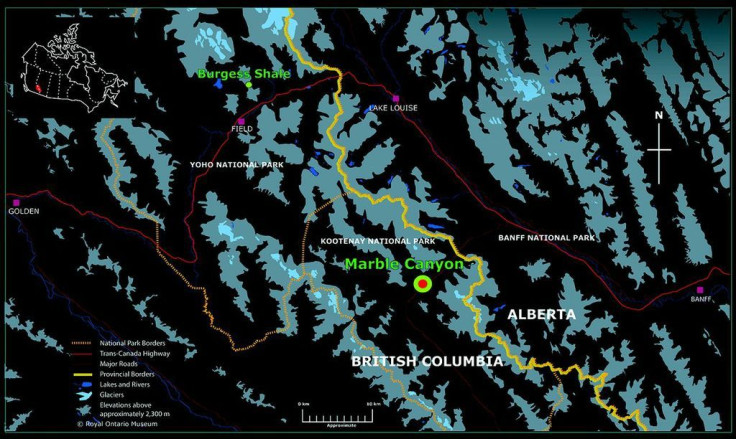Is Marble Canyon The New ‘Motherlode’? Fossil Site Found In Canada Considered ‘Epic’ Discovery [PHOTO]

A new fossil site discovered in the Canadian Rockies has unearthed 50 animal species in just 15 days.
The site, located in Kootenay National Park in Radium, British Columbia, was discovered in the summer of 2012 by a team of paleontologists. The team’s findings, described in the journal Nature Communications, reveals how the Marble Canyon fossil beds are a treasure trove of fossilized arthropods, a group that represents more than 80 percent of all living animals today, the Canadian Broadcast Corporation reports.
“This new discovery is an epic sequel to a research story that began at the turn of the previous century, and there is no doubt in my mind that this new material will significantly increase our understanding of early animal evolution,” Dr. Caron, a paleontologist with the Royal Ontario Museum, and leader of the international team that made the discovery told the Globe and Mail.

Caron says the discovery may prove greater than the Burgess Shale, a site 26 miles away. But unlike the 505 million-year-old Burgess Shale, which has uncovered approximately 200 animal species in more than 100 years of research, the discoveries at the Marble Canyon site are happening frequently and quickly -- within days.
“The rate at which we are finding animals – many of which are new – is astonishing, and there is a high possibility that we’ll eventually find more species here than at the original Yoho National Park site, and potentially more than from anywhere else in the world,” Caron said.
The fossils are about 100,000 years younger than those from the first Burgess Shale site. But the specimens at Marble Canyon found are better preserved, retaining very fine, never-before-seen anatomical details. Some species identified at the Canadian site are the same found in China’s famous Chengjiang fossil beds, which are 10 million years older. This adds weight to the notion that the distribution of Cambrian animals, as well as their longevity, might have been underestimated.
"I think the most profound implication is that the Burgess Shale can't just be the only one that there is," Robert Gaines, a geologist at Pomona College in Southern California, told LiveScience. "There's a lot more out there in the Canadian Rockies and other places."
The exact location is being kept private to prevent looting. The team found the site while looking for exposed sections of rock similar to those in the Burgess Shale.
“We had a hunch that if we followed the formation along the mountain topography into new areas with the right rock types, maybe, just maybe, we would get lucky — though we never in our wildest dreams thought we’d track down a motherlode like this,” Gaines told the CBC. “It didn’t take us very long at all to realize that we had dug up something special. To me, the Burgess Shale is a grand tale in every way imaginable, and we are incredibly proud to be part of this new chapter and to keep the story alive and thriving in everyone’s imagination.”
© Copyright IBTimes 2024. All rights reserved.






















